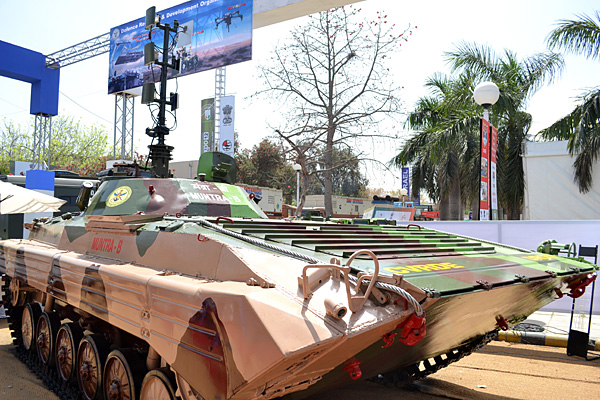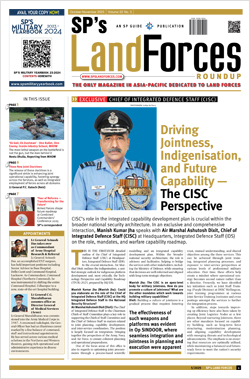INDIAN ARMED FORCES CHIEFS ON OUR RELENTLESS AND FOCUSED PUBLISHING EFFORTS

The insightful articles, inspiring narrations and analytical perspectives presented by the Editorial Team, establish an alluring connect with the reader. My compliments and best wishes to SP Guide Publications.

"Over the past 60 years, the growth of SP Guide Publications has mirrored the rising stature of Indian Navy. Its well-researched and informative magazines on Defence and Aerospace sector have served to shape an educated opinion of our military personnel, policy makers and the public alike. I wish SP's Publication team continued success, fair winds and following seas in all future endeavour!"

Since, its inception in 1964, SP Guide Publications has consistently demonstrated commitment to high-quality journalism in the aerospace and defence sectors, earning a well-deserved reputation as Asia's largest media house in this domain. I wish SP Guide Publications continued success in its pursuit of excellence.
- Appointments Committee of Cabinet approves one-month extension in service of Chief of the Army Staff
- Prime Minister witnesses 'Bharat Shakti' – a Tri-Services Firing and Manoeuvre Exercise in Pokhran, Rajasthan
- Interim Defence Budget 2024-25 — An Analysis
- Union Defence budget 2024
- Indian Army: In quest of greater firepower and policy recommendations for gaps
- Indian Army Annual Press Conference 2024
- Tata Boeing Aerospace Delivers 250 AH-64 Apache Fuselages, Manufactured in India
First indigenous unmanned tank
 |
By Lt. General P.C. Katoch (Retd) Former Director General of Information Systems, Indian Army |

In 2006, it was announced that India will be pursuing technologies for developing a robotic army. The impetus obviously was the realization that transnational actors and unconventional forces pose a growing threat when compared to the risk of a traditional inter-state conflict, plus robotic plans announced by other nations like the Killbots Army planned by the Republic of Korea. Militaries will continue developing robots for their own purposes. Technological advances enable the developers to build new systems for more tasks. UGVs will continue to be progressed.
In the US, an unmanned covered Humvee was driven around at a speed of 56 kmph without deviating from its planned route. Such capability would have multiple applications, saving human costs and lives. Obviously such future platforms would be fitted with cameras and weapons as well. Smaller robots of the size of a golf cart (Gladiator – carrying a machine gun, rockets and non-lethal weapons) have already been developed that can be controlled by PlayStation video game controller or software plug-ins, allowing semi-automatic and fully autonomous modes. Then is the medial robot 'Bloodhound' (improved version of the 'packbot') which can locate wounded soldiers, checking vital functions and administer morphine. US has already produced a working automated sentry gun and is currently developing it further for commercial and military use. The US Army has also been developing an Autonomous Rotorcraft Sniper System consisting of a remotely operated sniper rifle attached to an unmanned autonomous helicopter intended for use in urban combat or other missions requiring deployment of snipers. In all probability this system is already deployed. Similarly to ground robots, USVs and UAVs are also being researched further incorporating weapons and surveillance devices. In line with these modern trends, the DRDO has recently developed India's first unmanned tank, nicknamed 'Muntra'. Two of these remote operated vehicles were recently on display at the exhibition 'Science of Soldiers' organized by DRDO at the Combat Vehicles Research and Development Establishment (CVRDE) in Avadi, as tribute to our former President Dr APJ Abdul Kalam.
The testing and validation of Muntra unmanned tanks was undertaken at Mahajan field firing ranges in Rajasthan in extreme dusty and high temperature conditions (temperatures touch 50-52 degrees in these ranges). The Muntra is suited for missions like surveillance, mine detection, and investigating areas with nuclear and biological threats. Three versions of Muntra have been developed: 'Muntra-S' for unmanned surveillance mission; 'Muntra-M' for detecting mines; and, 'Muntra-N' to detect nuclear radiations or bio weapon risks in the suspected areas. It is not known whether combining all three functions or at least combining the first two functions (surveillance and mine detection) is being examined but at least the latter would be useful. The Muntra tank has an integrated camera along with laser range finder and surveillance radar. The integrated camera and the laser range finder help locating ground targets at a range of 15 kms ranging from crawling men to heavy vehicles.
Muntra is a good development by DRDO and adds a new dimension of employment of Unattended Ground Vehicles (UGVs) by the security forces. The Muntra, developed and tested for the Army by the CVRDE in Avadi, has also been sought by the paramilitary forces (PMF) in Maoist infested areas. For use in anti-Maoist areas, the PMF would obviously need to mull over and formulate standing operation procedures (SOPs) for the manner in which the Muntra should be employed taking into account the losses in Mine Protected Vehicles (MPVs) they suffered in such operations that led to eventually discarding the use of MPVs in these areas altogether. Examining how Maoists targeted MPVs and methods to circumvent it would be crucial since Maoists are adept in use of mines and improvised explosive devices (IEDs) including using 80-100 kg explosives in dugouts under roads and culverts; core of Maoists having been trained by the LTTE under aegis of Pakistan's ISI. Similarly, the Army would need to work out the employability of the Muntra singly, in pairs or in multiples depending on the envisaged tasks and deployment areas keeping in mind the production capacity by the DRDO. Japanese Prime Minister Shinzo Abe had announced plans to host a "Robot Olympic" in Japan in 2020. The DRDO and private industry should join hands to enable India to participate in big way. This could be jointly coordinated by the Ministry of Science & Technology and the Ministry of Commerce and Industry under overall direction of the Prime Minister's Office.





